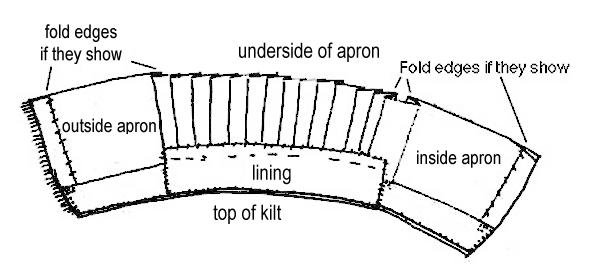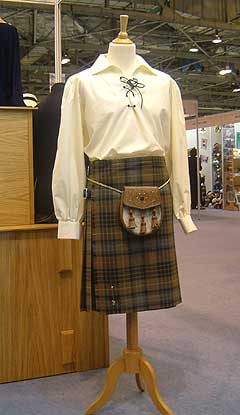Questions and answers about kilts
Q
From: "Kirsty McTear" <[email protected]>(Altered email to avoid
spamming)
To: "'Alan Trivett'" <[email protected]>
Sent: Wednesday, May 26, 2004 9:33 AM
Subject: RE: Ross Hunting Dress ladies
kilt
> Hiya,
>
> It arrived this
morning, directly from the makers complete
> with 2 flashes and the additional material.The material is self edged,
but
> they have mucked up this pleat and hemmed it.
I am somewhat surprised that the
> kilt arrived with only 2 buckles and no hip
buckle.
> ..basting threads.
Dear Kirsty,
Thanks for taking the time to write down the kilt
problem. I'm pleased to be able to set your mind at rest on some of the issues
you have raised.
First of all, the small triangular folds at the
corners of the selvedge hem on the inner apron. You will only find these
on a hand made kilt where the attention to detail is paramount. It is a sure
sign that you are dealing with a well trained kilt maker.
Here is a drawing from http://www.scottishdance.net/highland/MakingKilt.html

"Fold edges if they show", explains the problem
very neatly - without the triangle the edges will show!
A
 Secondly, you've caught me out on the picture of
the casual kilt which I took at the Scottish Trade Show. These "casual" kilts
are machine made by Lochcarron and come with a third buckle as standard.
I should have emphasised that all our own hand made kilts come with only two
buckles, unless specially requested. In J Charles Thompson's book, he says,
"Some tailors add a third strap ... which holds the top sewn portion better in
place during the most violent spins either dancing or throwing the hammer. ...
but even when most carefully adjusted, tends to pull the squares of the tartan
at the top of the apron a little askew." So I think it is really a matter of
preference. I will amend our web site to make the buckle position
clear.
Secondly, you've caught me out on the picture of
the casual kilt which I took at the Scottish Trade Show. These "casual" kilts
are machine made by Lochcarron and come with a third buckle as standard.
I should have emphasised that all our own hand made kilts come with only two
buckles, unless specially requested. In J Charles Thompson's book, he says,
"Some tailors add a third strap ... which holds the top sewn portion better in
place during the most violent spins either dancing or throwing the hammer. ...
but even when most carefully adjusted, tends to pull the squares of the tartan
at the top of the apron a little askew." So I think it is really a matter of
preference. I will amend our web site to make the buckle position
clear.
A
Thirdly, the basting is intended
to preserve the pleats, so it is right to remove it. The lighter weight
fabric is, perhaps, less able to hold its shape and will require more
pressing. I hope this
will not spoil your appreciation of the garment.
I hope these explanations will go some way to
re-assure you that the items you have purchased are indeed of top
quality. You may be interested to know of a story I heard about kilt
wearing in former times, that a workman would tie his kilt with the outer
apron left to right on working days and right to left on Sundays to keep the
apron clean. Our normal practice, now-a-days, is to make ladies and gents
kilts the same, but to change direction for ladies apron front kilted
skirts.
Best regards,
Blair Urquhart
HOUSE of TARTAN